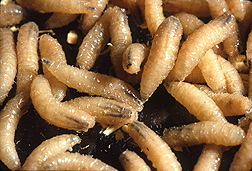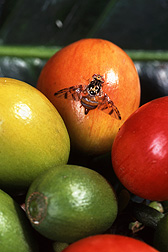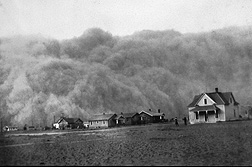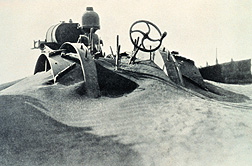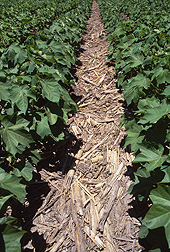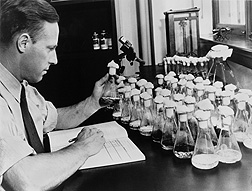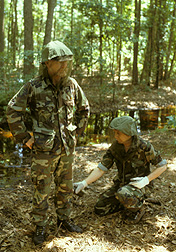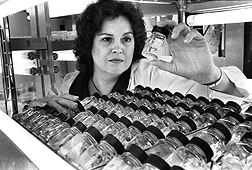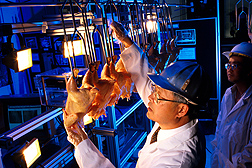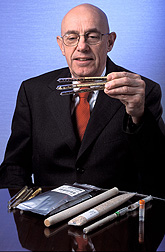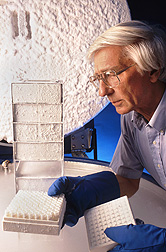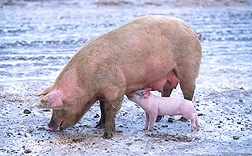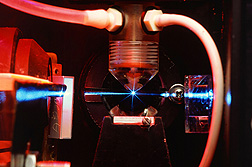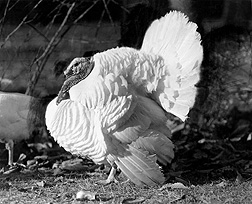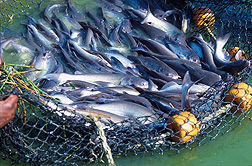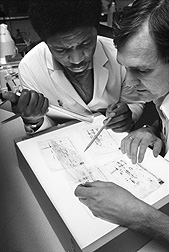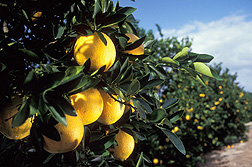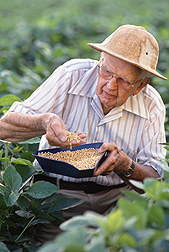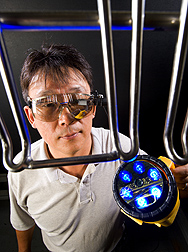150 Years of Making History
USDA's 150th Anniversary
May 15, 2012
|
|
The only thing that stands between the United States and an invasion of cattle-killing screwworms is a daily flight of airplanes flooding a 100-mile-wide section of the Isthmus of Panama with male screwworm flies raised in a laboratory and sterilized with radiation in Panama. The screwworm infestations of the past would probably come back if the releases stopped for a couple of months or so, says Dan Strickman, Agricultural Research Service national program leader for veterinary and medical entomology.
“This is a great example of agricultural research changing the history of this country, and it’s a cutting-edge example of integrated pest management,” Strickman adds.
This year marks the U.S. Department of Agriculture’s 150th anniversary, making it a particularly appropriate time to look at this and other examples of history in the making.
|
|
The screwworm was wiped out of the United States by 1966 and Mexico by 1991. The purging continued south to include Central America until the “barrier” reached across the entire narrow Isthmus of Panama, and the screwworm was declared eradicated from Central and North America.
Before USDA eradicated the species from the United States, the screwworm—larvae of which eat living tissue of people and other animals—had plagued the Southwest, all of Florida, and parts of Georgia.
In 1937, the late Edward F. Knipling, then at a USDA laboratory in Menard, Texas, got the idea of flooding areas with sexually sterilized male screwworm flies. He believed that by releasing large numbers of sterile male flies, they would mate with nonsterile female screwworm flies and that the resulting “unsuccessful” mating would decrease the population over time, driving the flies to extinction.
|
|
When Knipling came up with the idea, there was no known way of sterilizing the male flies. Then one day he read an article by the Nobel Prize-winning geneticist Hermann Joseph Muller in Scientific American showing that x-rays sterilized male fruit flies without interfering with their normal functions.
Knipling wrote to Muller to see whether x-rays could be used to sterilize screwworm flies. Muller wrote back immediately, indicating his interest in the idea.
That exchange—and subsequent experiments demonstrating that the idea worked, including research by colleague Raymond Bushland showing that sterile male screwworms could be raised in a laboratory and function normally after release, including mating with nonsterile females—led to the historic screwworm eradication program.
The sterile insect technique has been used to eradicate screwworms elsewhere, including north Africa—where they were accidentally introduced—in the 1990s and most recently from Aruba. The technique has proved useful in controlling other pests as well, such as the Mediterranean fruit fly and the tsetse fly.
|
|
USDA screwworm research began under the auspices of the department’s Bureau of Entomology and Plant Quarantine, which was transferred to the Agricultural Research Administration (which became the Agricultural Research Service by the end of 1953). The laboratory at Menard was incorporated into the U.S. Livestock Insect Laboratory in 1946, which, in 1988, was renamed the Knipling-Bushland U.S. Livestock Insects Research Laboratory in honor of the two pioneering scientists. The facility, located in Kerrville, Texas, works on cattle fever ticks, horn flies, stable flies, and other livestock pests. Live screwworms are not allowed in the United States, however, so the lab can only work with DNA from the screwworm. The live-screwworm work is performed at the Screwworm Research Unit in Pacora, Panama, the site of a huge factory that produces sterile males for release. The Kerrville lab continues to research effective, less expensive methods to control insect pests of livestock.
|
|
Keeping Soil Where It Belongs
Another example of USDA research changing history occurred in 1938, when the USDA Soil Conservation Service [now the Natural Resources Conservation Service (NRCS)] and the Texas Agricultural Experiment Station created a laboratory in Bushland, Texas, in the wake of a dramatic wind erosion event. Poor agricultural practices for years, coupled with severe drought, left the soil of extensive U.S. farmland exposed. The result was a multiyear period of severe dust storms in the 1930s. Known as the “Dust Bowl,” it was characterized by thick, black clouds of dirt and dust stretching across several states and millions of acres.
The Bushland lab’s charge was to prevent the intolerable conditions of another potential Dust Bowl and to minimize wind erosion, working with other state experiment stations—such as those in Kansas and Ohio—and other USDA labs.
They developed stubble mulch tillage, leaving the residue of harvested crops on the land over winter to keep soil from blowing away and to save precious soil moisture. This was the forerunner of the highly successful practice of no-till and other forms of conservation tillage that drastically reduced erosion, whether by wind, rain, or snowmelt. ARS research was spurred further by the drought of the 1950s. At the time, there were limitations to stubble mulch, mainly lower yields, so ARS set out to overcome those limitations and, in time, succeeded in making conservation tillage an NRCS-recommended “best practice.”
ARS Bushland scientists continue conservation tillage research to this day, improving techniques and adjusting to modern challenges. They have learned to harness wind energy to produce electricity for use in homes and on farms. They continue research on water conservation, taking advantage of the latest technology. Today, that means getting information on soil moisture from satellites.
It is unlikely that the Great Plains will suffer another Dust Bowl as severe as the one in the 1930s. Isolated yet significant storms are inevitable, but the conservation tillage and crop residue management techniques developed from ARS research will certainly reduce the severity of dust storms in agricultural regions.
Six Nutrition Research Centers and Four Regional Research Centers
|
|
USDA-ARS human nutrition research also changed the history of the nation and continues to do so. This research has long affected the daily lives of Americans, although the average person may not realize it. Let’s start with breakfast: The calorie content, fat percentage, and nutrient content on the label of the cereal box are required by the U.S. Food and Drug Administration (FDA), using ARS data that traces back to the work of Wilbur Olin Atwater, the father of American nutrition, in 1894. He began the food analysis that today is listed on food containers. He also pioneered the surveys of people’s eating habits that continue to the present. Today, nutrition research is carried out by six ARS human nutrition centers in Arkansas, California, Maryland, Massachusetts, North Dakota, and Texas. For example, definitive human feeding studies at the Beltsville, Maryland, center showed the health benefits of limiting trans fat consumption. This led to FDA requiring food labels to include trans fat content and to food companies reformulating products to lower their trans fat content.
Ironically, nutrition research in the early days was directed at making sure Americans got enough to eat; today, research has to deal with obesity problems as well.
Many new products in the home—both food and nonfood—were a result of USDA-ARS research beyond the human nutrition labs. Many of these were from research efforts at four regional research centers established in 1938 to find new uses for agricultural commodities. Today, all four of these centers are designated American Chemical Society historical landmarks for specific scientific achievements. Those centers, strategically located across the country—in California, Illinois, Louisiana, and Pennsylvania—were created to help end chronic farm depression by finding new, value-added uses for surplus crops. By the end of 1940 and early 1941, research began at the centers, and many new value-added products—still in use today—were created as a result.
|
|
Adding lactose-free milk to cereal? ARS technology is used to make that milk. That glass of orange juice made from frozen concentrate tracks to ARS’s development in the 1950s of a way to freeze the concentrate. Popping a frozen waffle in the toaster? ARS developed techniques for freezing that waffle and other foods. ARS scientists began a project in 1948 that eventually led to nine principles for freezing vegetables that remain the industry standard. Jelly on toast? ARS had a hand in developing jelly from fruits.
More recently, ARS worked with industry partners to develop a process for making sunflower seed butter as an alternative to peanut butter for children allergic to peanuts. “Frozen orange juice, sunflower seed butter, and lactose-free milk are probably among the top food and drink products developed with ARS technology in terms of dollar value in sales,” says David Klurfeld, ARS national program leader for human nutrition.
|
|
USDA-ARS successes from research conducted at the centers also include instant mashed potatoes, explosion-puffed dehydration technology used to dry foods, and the SuperSlurper starch-based product used in making super-absorbent diapers, baby powder, wound dressings, automotive products, and agricultural and horticultural products, to name a few. The list goes on: a coating to keep fresh-cut fruit, like apple slices, from browning, now available at fast-food restaurants and grocery stores; Oatrim fat substitute made from oat bran, used in ice cream and other foods to lower fat and calorie content; Sucromalt low-glycemic sweetener used in some food products to help consumers stabilize and lower blood sugar levels; soy-based fuels, inks, and hydraulic fluids; and compostable bowls, cups, plates, and trays.
People who wake up between cotton sheets and put on cotton clothing—whether permanent press, wash-and-wear, or flame-retardant—may not realize that they are benefiting from ARS research on improving cotton quality, processing, and use.
|
|
The War Effort and Beyond
ARS researchers started shaping history immediately, and their efforts supported the United States and allies in World War II. In 1940, ARS chemists in Peoria, Illinois—at the request of Great Britain—found a way to produce penicillin, discovered in 1928, as a powder suitable for medicine. Then they found a way to produce the drug in quantity, using their expertise in growing molds in large fermentation vats. By the end of 1942, 17 U.S. firms were making penicillin pills.
Peoria researchers found a superior, more productive Penicillium strain on a moldy cantaloupe from a local market. They gave that mold to the drug companies, and the companies produced enough penicillin to treat allied soldiers wounded on D-Day.
The Peoria lab’s expertise and techniques have been used in developing many other products—including the food thickener xanthan gum, biobased fuels, and other biobased products—and in modern genetic research.
As part of the U.S. Emergency Rubber Project during World War II—aimed at finding domestic rubber sources—research at Wyndmoor, Pennsylvania, and other USDA labs helped improve the production of synthetic rubber. Their research was essential to the Allied victory, and remains useful to this day for producing domestic rubber.
|
|
ARS researchers developed DEET to repel mosquitoes and other pests during wartime while looking for alternatives to citronella—which was in short supply at the time. ARS also came up with techniques for making military clothing resistant to biting insects, mildew, rot, and oil-based liquid chemical weapons. Other wartime discoveries included better bandages, dextran (a blood plasma substitute made from sugar beet pulp and sugarcane), and MRE (Meals Ready to Eat) food items for the military.
Many of ARS’s discoveries and techniques developed during wartime have led to peacetime uses that have extended to today.
|
|
Abundant, Safe Food
ARS research has always had an international aspect. Perhaps the best example is the work leading up to the Green Revolution—a period of increased worldwide agricultural production. In 1946, an ARS agronomist collected seeds of short-statured wheats in Japan. These seeds were later distributed to various U.S. wheat breeders, including a team led by ARS breeder Orville Vogel, in Pullman, Washington. The group developed high-yielding, semi-dwarf wheat varieties that were further improved by the late Norman Borlaug, of the International Maize and Wheat Improvement Center, to avert famines worldwide.
Upton Sinclair’s The Jungle, an exposé of meat-processing practices of the past, resulted in the Meat Inspection Act of 1906 and the beginnings of a formal food safety agency at USDA. Although USDA-ARS research has always had a food safety aspect, a formal national research program was created in 1997 with the Food Safety Initiative under President Bill Clinton.
Today, ARS’s food safety research includes robotic inspections of poultry and goes beyond meat to include all foods. A good example is an effort over the past decade by ARS researchers at Clay Center, Nebraska, and their colleagues. These scientists have been sequencing genes to find those that can be used as markers for serotypes of Escherichia coli that produce Shiga toxin. Through this work, they have worked with industry partners to develop assays for Shiga toxin-producing E. coli, including E. coli O157:H7, which causes foodborne illness.
This food safety program traces back to earlier research: A USDA chemist in 1882 was one of the first to analyze the bacterium that causes tuberculosis. USDA scientists over the years also showed the value of pasteurizing milk and determined the cooking temperature needed to kill the pathogen that causes trichinosis.
The Objectives of USDA’s First Leader
By signing a bill on May 15, 1862, President Abraham Lincoln established USDA. From there, history moved swiftly as the Morrill Land Grant College Act (July 2, 1862) was signed, authorizing public land grants for colleges to teach agriculture and mechanic arts and leading to the establishment of major state-operated agricultural research centers.
On July 1 of the same year, Isaac Newton was appointed the first commissioner of agriculture. The new commissioner listed seven original objectives in his first report as head of the new department. In 1889, USDA achieved cabinet status, and these seven objectives have continued to be pursued by the department’s agencies to the present day.
“Testing Agricultural Implements”
|
|
“Testing agricultural implements” was one of Newton’s seven original objectives.
The National Soil Dynamics Laboratory, originally founded as the Farm Tillage Machinery Laboratory in 1933, is located on the campus of Auburn University in Auburn, Alabama. The lab was initially charged with researching tillage, associated traction practices, and machines used in cotton production, but its scope was soon extended to include all types of tillage, traction machinery, and practices. In 1957, the laboratory became the National Tillage Machinery Laboratory.
In its first 50 years, the laboratory contributed to the understanding of soil compaction and its management. In 1990, the American Society of Mechanical Engineers and the American Society of Agricultural Engineers designated the laboratory as a historic landmark.
Collect, Test, and Distribute New Seeds and Plants
The law that President Lincoln signed to create USDA authorized Newton and future department leaders to collect, test, and distribute new seeds and plants. In 1947, USDA organized the National Foundation Seed Project to help states rapidly build up seed supplies. Today, ARS maintains a national system of seed storage banks, the National Plant Germplasm System. The system’s 20 genebanks and support units hold germplasm for scientists, breeders, farmers, and others to use. “Germplasm” refers to the parts of plants and animals that are needed for reproduction, like seeds or semen.
More than half a million germplasm samples from around the world are stored in containers housed in secure vaults at the National Center for Genetic Resources Preservation (NCGRP), formerly known as the National Seed Storage Laboratory—the central bank of the system.The seeds are stored at low temperatures—either 0°F or over liquid nitrogen at –292°F. Each of the 19 other genebanks contains certain species of plants, whereas NCGRP contains backup versions of them all and is the only one that also stores animal germplasm.
“Introducing Valuable Plants and Animals”
|
|
Another of Newton’s seven goals was “Introducing valuable plants and animals.”
Over the last 150 years, numerous scientific discoveries and research milestones have contributed to U.S. animal and plant production, ensuring that our foods are abundant, safe, and sustainable. In that tradition, ARS’s ability to respond to our nation’s needs—either in adapting to food security threats or in offering solutions to consumer needs—is also evident in groundbreaking research that saved and helped revolutionize several industries.
In 1833, hog cholera (also known as “classical swine fever”) was first reported in the United States. Highly contagious to pigs and wild boar, the disease continued to spread, devastating the swine industry and ultimately jeopardizing pork production. Demonstrating its ability to respond in a crisis, ARS established the Hog Cholera Research Station in Ames, Iowa. The Ames station conducted research and diagnostic services on hog cholera until the National Animal Disease Laboratory opened in 1961 and later became the flagship for USDA’s animal disease work. This lab continues to study major poultry and livestock diseases to help protect our nation’s meat and poultry supply.
Germplasm collections preserve valuable genetic material for future generations. One of the many benefits of saving precious germplasm is protection against devastating diseases and pests and identification of important traits. The National Animal Germplasm Program houses animal germplasm from animals past and present. The collection contains semen from Hereford and Holstein bulls from the 1950s to today. In addition, the repository has acquired semen samples from Limousin, Simmental, and Salers bulls that were originally imported from Europe in the late 1960s. Most recently, the repository has acquired a broad array of genetically diverse samples of Jersey cattle from Jersey Island, where the breed originated and from where it was first imported into the United States in the 1800s. The repository also houses germplasm from numerous sheep and swine breeds, including some from as far back as 1965. These collections serve as germplasm “insurance policies” for the animal production industries, protecting against loss of valuable germplasm diversity.
In 1935, USDA initiated its National Poultry Improvement Plan to improve production and marketing qualities of chickens and turkeys through performance testing. Years later, a major milestone was reached, changing the meat quality of turkey: ARS released the Beltsville Small White, a small, meaty, full-breasted turkey, in 1941. This bird met consumer needs and demands for a smaller turkey. Before the Beltsville Small White, the average weight of an adult tom turkey was a whopping 33 pounds. Some breeds were too big to fit in apartment-sized ovens and refrigerators. Thanks to USDA, today’s turkeys and chickens—enjoyed year round—are extremely efficient and yield an abundance of lean meat.
In 1917, USDA started a long-term dairy herd improvement program that has led to a tremendous increase in milk production. The program continues to this day under ARS and is setting the standard domestically and internationally for genetic and genomic technology development and implementation.
The ARS Hereford cattle improvement breeding program began in 1934 in Miles City, Montana. Today the average Hereford contains more than 40 percent genetic material from the ARS Line 1 Hereford cattle. Research in beef cattle genetics at the U.S. Meat Animal Research Center quantified the value of numerous breeds and crosses for the beef industry. This research was extremely valuable and was used to develop most industry crossbreeding programs. Beef industry research in efficiency, reproduction, meat quality, and genetics is ongoing at ARS.
|
|
USDA scientists have changed the food industry—developing vaccines, processes, and technologies to protect our food, from the farm to our tables. When Marek’s disease posed a threat to the poultry industry, ARS poultry scientists in East Lansing, Michigan, were first to develop a way to vaccinate chicken embryos against the disease. This disease attacks birds’ nervous systems and kills more birds than any other disease. In 1987, ARS entered into its very first cooperative research and development agreement (CRADA) with Embrex Inc., of Research Triangle Park, North Carolina. This was the first CRADA between any private company and government lab under the Federal Technology Transfer Act of 1986. The act allowed more flexibility in federal-industry research and development. ARS licensed its egg-infection technology to Embrex, which enabled the company to innoculate 20,000 to 50,000 eggs per hour.
Other research has led to vaccines for H1N1 influenza virus, foot and mouth disease, mastitis, porcine reproductive and respiratory syndrome, avian leukosis virus, and brucellosis.
|
|
Aquaculture is an industry that provides half of the world’s seafood. ARS’s aquaculture program has proven invaluable to U.S. fish farmers, from improving production practices to breeding and improving fish varieties, like catfish, salmon, trout, and tilapia, to developing new vaccines to ensure healthy fish. Notably, ARS scientists in Auburn developed several vaccines that protect fish against major diseases, like those caused by Streptococcus iniae and Flavobacter columnaris, emerging bacterial pathogens in cultivated catfish, tilapia, hybrid striped bass, rainbow trout, and others. These vaccines offer alternatives to antibiotics or chemical treatments.
Groundbreaking animal research includes inventing highly sophisticated breeding techniques and tools. ARS researchers developed, patented, and licensed the Beltsville Sperm Sexing Technology—a method that separates female-producing sperm from male-producing sperm based on DNA content. The technique helps speed the rate at which farmers can achieve genetic improvement while reducing production costs. More recent achievements include working with industry and university partners to develop a BeadChip, a genomic method used to analyze cattle DNA—and now sheep, pig, and plant DNA—to identify bulls that produce offspring with optimum milk production and other traits.
|
|
USDA scientists have conducted decades of crop production research to ensure a sustainable bounty of fresh fruits, vegetables, and other staples, like peanuts, wheat, rice, and soybeans—all while protecting our environment. Many new varieties of fruits and vegetables—including grapes, oranges, blueberries, cranberries, peaches, apricots, tomatoes, watermelon, potatoes, carrots, lettuce, cucumbers, peppers, apples, and more—were developed at USDA-ARS labs.
Red seedless table grapes were all but unknown to the U.S. consumer before USDA-ARS released the seedless grape Flame in 1973. In 1989, ARS released Crimson, which further increased table grape popularity. These two varieties alone, grown extensively by both domestic and foreign producers, make up a majority of today’s consumer market, although several newer USDA-ARS varieties have also taken hold of the U.S. table grape industry: Autumn Seedless, Thompson, Sweet Scarlet, Scarlet Royal, and Autumn King.
More than 70 percent of the citrus grown in the United States is from ARS-developed varieties or rootstock. ARS researchers in Florida have developed citrus that is high yielding, disease resistant, more colorful, and has a longer shelf life. Current research efforts are focused on protecting the U.S. citrus crop from citrus greening disease, one of the most severe citrus diseases.
Nearly every head of iceberg lettuce you’ll find in a supermarket owes its parentage to the work of ARS plant breeders. The ARS gene bank contains more than 2,000 types of lettuce. Researchers in California recently released three new leaf lettuce breeding lines with resistance to corky root, a serious disease of lettuce.
Blueberries, a nutritional power fruit, were not always the stars they are today. In the Gulf Coast region, growing blueberry crops is possible, thanks to ARS early-ripening varieties. Today, more than 10,000 acres are planted to Dixie—an ARS-developed variety—with more than 4,000 acres thriving in Texas, Louisiana, and Alabama. ARS researchers are now studying the compounds in blueberries and other berries and the effects of those compounds on nutrition and health.
Potatoes are popular whole, sliced, diced, mashed, or chipped. ARS’s potato breeding program continues to deliver new varieties that are resistant to various diseases and pests and are high in nutrition. Recent research also targets zebra chip disease, a problem for potato growers since it was detected in 2000. Since then, it has caused millions of dollars in production and processing losses.
These are but a few of many examples of the successful fruit and vegetable research at USDA-ARS. One cannot visit a supermarket or farmers market without encountering a fruit or vegetable that got its start at ARS.
“Establishing an Agricultural Library”
|
|
Newton’s original goals also included “establishing an agricultural library.” This goal was an outgrowth of the 1862 act that established USDA and ordered the commissioner “to acquire and preserve . . . all information concerning agriculture.” Newton wasted no time. By 1863, around 1,000 volumes from the Agricultural Division of the Patent Office were moved to USDA to form the nucleus of this new library. After 100 years of service, it was designated the “National Agricultural Library” (NAL) and moved to Beltsville, Maryland.
Today, while that building still houses seemingly endless stacks of papers, books, and other items, the library’s real growth comes digitally, with new, often specialized content finding its way to the Web for NAL’s global customers. The NAL Digital Collections currently delivers nearly 25,000 USDA full-text publications, 45,000 scholarly articles, and the 7,584 technically accurate watercolor paintings, prints, and drawings of fruits and nuts that comprise the USDA Pomological Watercolor Collection. This ever-growing collection knocks down the barriers to finding government-produced agricultural research and informative historical works.
Under development is NAL’s Life Cycle Assessment Digital Commons. It collects data that reflects how products derived from agriculture are grown, made, and used. Currently, such life cycle data is dispersed and often difficult to find, but the Digital Commons will bring that data from across the agricultural sector into one easy-to-use location.
“Conducting Chemical Analyses of Soils, Grains, Fruits, Plants, Vegetables, and Manures”
Newton’s goal of “Conducting chemical analyses of soils, grains, fruits, plants, vegetables, and manures” is now done with technology beyond Newton’s imagination. ARS scientists at Beltsville developed the Beltsville Universal Computerized Spectrophotometer, which led to near-infrared instruments to analyze and grade bulk grains like wheat and corn—as well as perform forage quality tests, manure analysis, and switchgrass grading for ethanol potential. Researchers continue to expand these techniques to develop cost-effective ways to rapidly improve bioenergy crops.
ARS researchers are also using innovative remote sensing techniques to develop close-up, hands-off inspection of meat and poultry, fruits, vegetables, and whole-kernel grains. Recent developments include an automated hyperspectral image analysis system—which uses digital imaging and visible/near-infrared spectroscopy—that can scan 140 poultry carcasses per minute during food safety inspection. Similar systems are used for quality inspection and detecting contaminants in fruits, vegetables, and grain to reduce their potential for causing foodborne illnesses.
|
|
ARS continues its research in these and other areas with an emphasis on lessening our global footprint. USDA researchers are learning more about how weather, climate, and water resources affect agricultural production and the environment. Today, USDA researchers and industry and university partners work collaboratively to explore environmental practices that will benefit farmers, consumers, and the world.
At USDA’s sesquicentennial, ARS and all the other agencies that make up the department today are continuing to follow Newton’s “Seven Commandments”—but with ever-changing technologies and challenges, most of them unimagined in 1862.—By Don Comis, formerly with ARS, Tara Weaver-Missick, ARS, and Robert Sowers, Agricultural Research Service Information Staff.
"150 Years of Making History: USDA’s 150th Anniversary, May 15, 2012" was published in the May/June 2012 issue of Agricultural Research magazine.








